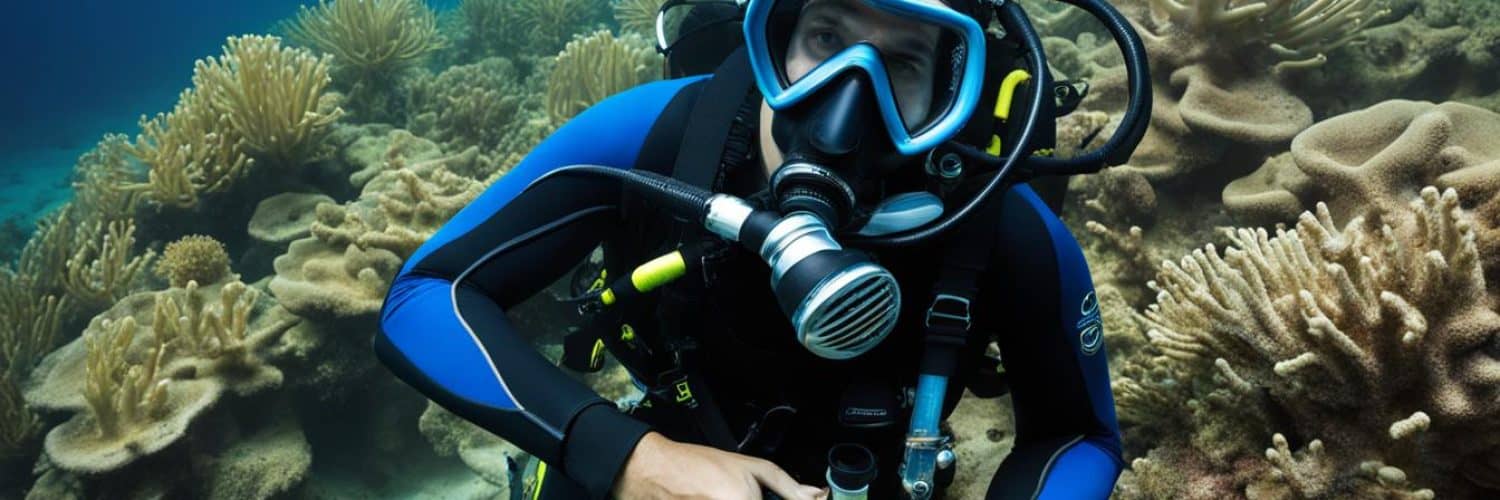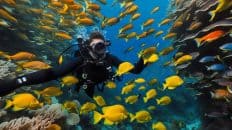When it comes to scuba diving, having the right equipment is essential. And one of the most important pieces of equipment for any diver is a scuba regulator. A scuba regulator ensures that you can breathe underwater comfortably and safely, allowing you to explore the wonders of the ocean with ease.
But with so many options available on the market, finding the best scuba regulator can be a daunting task. That’s why we’ve done the research for you and curated a list of the top picks for the best scuba regulators for divers.
Key Takeaways:
- Choosing the right scuba regulator is crucial for a comfortable and safe diving experience.
- Consider factors such as the type of diving you’ll be doing, your budget, and the water temperature.
- Decide between a DIN or yoke regulator based on where you’ll be diving.
- Take into account the ease of breathing and choose a trusted brand.
- Ensure compatibility with the gases you’ll be using and consider the number of ports.
DIN vs Yoke Regulator: Which One to Choose?
When it comes to choosing the best scuba regulator, one of the main decisions you’ll need to make is whether to go for a DIN (Deutsches Institut für Normung) or yoke regulator. The choice between these two types depends on where you plan to dive and the type of tanks you’ll encounter.
If you primarily dive in places with yoke regulators, such as most dive operators in the United States, it’s best to choose a yoke regulator. The yoke regulator, also known as the A-clamp or international valve, is the most common type of regulator and easily fits onto the tanks commonly available at dive centers.
On the other hand, if you often encounter DIN valve tanks during your dives, it’s recommended to opt for a DIN regulator. DIN regulators have an internal O-ring that creates a secure seal with DIN valves, providing an added level of safety and protection against leaks. These regulators are popular in Europe and increasingly used worldwide.
Note: It’s important to be aware of the differences between DIN and yoke regulators and choose the appropriate one for your diving environment to ensure compatibility and safety.
“The choice between a DIN and yoke regulator depends on where you’ll be diving.”
If you’re unsure about which regulator to choose or anticipate diving in locations with both types of tanks, there’s an option to use a DIN regulator on a yoke tank by using a converter. However, it’s crucial to note that using a yoke regulator on a DIN tank can be a safety issue and is not recommended unless you have experience and know what you’re doing.
To help you visualize the key differences between DIN and yoke regulators, take a look at the table below:
| Regulator Type | Key Features |
|---|---|
| DIN Regulator |
|
| Yoke Regulator |
|
DIN vs Yoke Regulator Comparison
You can consider the following advantages and disadvantages when choosing between a DIN and yoke regulator:
DIN Regulator:
- Offers a secure seal and additional safety
- Compatible with DIN valves
- More common in Europe and certain regions
- May require an adapter for yoke tanks
Yoke Regulator:
- Easy to find and use in most dive centers worldwide
- May require an adapter for DIN valves
- Commonly used in the United States
- May not provide the same level of safety as DIN regulators
By understanding the differences between DIN and yoke regulators and considering your diving environment and tank preferences, you’ll be able to choose the most suitable regulator for your needs.
Consider Your Budget
When it comes to purchasing a scuba regulator, your budget plays a significant role in determining the options available to you. Scuba regulators can be broadly classified into three categories based on price: budget, mid-range, and high-end.
Budget Regulators
For beginners or those on a tight budget, budget regulators are an excellent choice. These regulators are typically priced up to around $350, making them affordable without compromising on quality or performance. They are designed to meet the needs of recreational divers who are just starting their scuba diving journey. Although they may not have all the advanced features of higher-priced regulators, budget regulators still provide reliable and safe performance underwater.
Mid-Range Regulators
If you’re looking for a scuba regulator that strikes a balance between price and performance, consider mid-range regulators. Falling within the price range of $350 to $799, these regulators offer a step-up in features and performance compared to budget options. Mid-range regulators are suitable for divers who have gained some experience and are looking for more advanced features and better durability. They often incorporate technological advancements to enhance breathing comfort and underwater performance.
High-End Regulators
For advanced divers seeking the highest level of performance and durability, high-end regulators are the top choice. Priced above $799, these regulators are designed to meet the demands of professional divers, technical divers, and those who frequently dive in challenging environments. High-end regulators typically feature cutting-edge technologies, superior materials, and adjustable settings for optimal customization. They offer exceptional breathing comfort and performance, making them ideal for deep diving, technical diving, and other demanding underwater adventures.
Remember, your budget is just one aspect to consider when choosing a scuba regulator. It’s essential to assess your diving needs, experience level, and future diving goals to make an informed decision.
Scuba Regulator Price Categories
| Regulator Category | Price Range | Key Features |
|---|---|---|
| Budget Regulators | Up to $350 | Affordable, suitable for beginners, reliable performance |
| Mid-Range Regulators | $350 – $799 | Better features and durability, suitable for experienced divers |
| High-End Regulators | Above $799 | Advanced features, exceptional performance, professional-grade |
With the right scuba regulator that fits your budget and diving needs, you can ensure a safe and enjoyable underwater experience.
Diving in Cold or Warm Water
When planning your scuba diving adventures, it’s essential to consider the water temperature you’ll be diving in. The performance and comfort of your scuba regulator can vary depending on whether you’ll be diving in cold or warm water.
If you’ll be diving in water colder than 57°F (14°C), it’s crucial to choose a regulator that is specifically designed for cold-water diving. These regulators are equipped with built-in mechanisms to prevent freezing and ensure optimal performance even in frigid conditions.
For divers exploring colder waters, environmentally sealed regulators are a popular choice. These regulators are designed to keep out water and contaminants, providing enhanced protection against freezing. With an environmentally sealed regulator, you can dive confidently in cold-water environments, knowing that your equipment will withstand the challenges.
On the other hand, if you’ll be diving in warm water, any high-quality scuba regulator will suffice. The warm-water diving experience is less demanding on equipment, allowing you the flexibility to choose a regulator based on other factors such as comfort and ease of breathing.
Remember, choosing a regulator that suits the water temperature you’ll be diving in is essential to ensure optimal performance and comfort throughout your dives.
Comparative Table: Cold-Water vs. Warm-Water Regulators
| Features | Cold-Water Regulators | Warm-Water Regulators |
|---|---|---|
| Freezing Protection | Equipped with built-in mechanisms to prevent freezing | No specific freezing protection |
| Environmental Sealing | Available | No specific sealing |
| Performance | Optimized for cold-water conditions | Suitable for warm-water environments |
| Comfort | Designed for prolonged use in colder temperatures | Comfortable for recreational warm-water diving |
| Price Range | Varies depending on model and features | Varies depending on model and features |
Consider Ease of Breathing
When selecting the best scuba regulator, ease of breathing is a crucial factor to consider. After all, you want a regulator that allows you to breathe effortlessly underwater, providing a smooth and comfortable diving experience.
To ensure ease of breathing, it’s important to look for trusted brands that are known for their high-quality regulators. You can also consult scuba forums and read reviews to gather insights and recommendations from experienced divers.
One key feature to consider is whether the regulator is balanced or unbalanced. Balanced regulators provide consistent airflow regardless of external conditions, ensuring a smooth breathing experience under various depths and breathing rates. On the other hand, unbalanced regulators may exhibit increased resistance at lower tank pressures, which can make breathing more difficult.
Piston-driven regulators are another option to consider. These regulators have a simple yet effective design that allows a larger volume of air to reach the second stage, enhancing ease of breathing.
Remember, when it comes to scuba regulators, safety should always be a top priority. Be cautious of knock-off regulators that may not meet safety standards. Opt for reputable brands and prioritize the quality and reliability of the regulator.
By carefully considering ease of breathing and choosing a high-quality regulator that suits your diving needs, you can ensure a comfortable and enjoyable diving experience.
Understanding Balanced vs Unbalanced Regulators
When choosing the best scuba regulator for your diving adventures, it’s important to understand the difference between balanced and unbalanced regulators. These two types of regulators operate differently and can greatly affect your dive experience.
Let’s start with balanced regulators. These regulators are designed to provide consistent airflow, regardless of external conditions such as the remaining gas in the tank, depth, or breathing rate. They feature advanced internal mechanisms that ensure a steady supply of air, even in challenging diving scenarios.
One of the key advantages of balanced regulators is their performance on deep dives. If you’re planning to explore depths beyond 130 feet (40 meters), a balanced regulator is highly recommended. Its ability to deliver consistent airflow allows for a smooth and comfortable breathing experience at greater depths.
Now, let’s talk about unbalanced regulators. Unlike their balanced counterparts, unbalanced regulators may exhibit increased resistance at lower tank pressures. This means that as the tank pressure decreases, you might feel more effort is required to breathe. Unbalanced regulators are more suitable for shallower dives and recreational diving scenarios.
| Key Considerations | Advantages | Disadvantages |
|---|---|---|
| Balanced Regulators |
|
|
| Unbalanced Regulators |
|
|
As you can see, balanced regulators offer superior performance and are ideal for divers planning more challenging dives. However, they do come at a higher price point due to their advanced internal mechanisms. On the other hand, unbalanced regulators are more budget-friendly but may not be suitable for deeper dives due to their increased resistance at lower tank pressures.
Ultimately, the choice between a balanced and an unbalanced regulator depends on the type of diving you’ll be doing and your personal preferences. Consider factors such as diving depth, budget, and your specific diving needs to make an informed decision.
Compatibility with Different Gases
When choosing the best scuba regulator, it’s crucial to consider its compatibility with different gases. Most regulators on the market are compatible with EANx (enriched air nitrox) up to 40% concentration, provided you have the necessary training and certification (source). EANx is a popular choice among divers looking to extend their bottom time and reduce their risk of decompression sickness. However, if you plan on engaging in decompression diving or using higher-percentage oxygen mixes, opting for a DIN regulator is highly recommended.
DIN regulators are specifically designed to handle the additional demands of decompression diving and higher-percentage oxygen use. These types of dives require a particular skill set, certification training, and experience to ensure safety (source). By choosing a DIN regulator, you can have peace of mind knowing that your equipment is designed to meet the demands of these specialized diving activities.
It’s important to note that using EANx or engaging in decompression diving without the necessary training and certification can be extremely dangerous. Only undertake these types of dives if you have the proper qualifications and experience.
| Gases | Regulator Compatibility |
|---|---|
| EANx up to 40% | Most regulators (with training and certification) |
| Decompression Diving | DIN regulators (with additional training and certification) |
| Higher-percentage oxygen mixes | DIN regulators (with additional training and certification) |
Number of Ports
When choosing the best scuba regulator, it’s essential to consider the number of ports it offers. This section explores the importance of both low-pressure and high-pressure ports and how they can enhance your diving experience.
Low-Pressure Ports
The majority of contemporary regulators are equipped with four low-pressure ports. These ports are crucial for connecting additional accessories, such as octopuses, dive computers, and inflator hoses for buoyancy control devices. Having multiple low-pressure ports ensures that you have enough flexibility to customize your diving setup according to your specific needs.
For recreational divers, it is recommended to choose a regulator with a minimum of three low-pressure ports. This allows for the attachment of essential diving equipment while still providing room for customization. Additionally, if you dive with a drysuit, you’ll need an extra port dedicated to adding air to your suit, ensuring optimal buoyancy control throughout your dive.
High-Pressure Ports
In contrast to low-pressure ports, scuba regulators typically have two high-pressure ports. These ports are used for connecting pressure gauges and transmitters, allowing you to monitor your tank pressure while diving. The high-pressure ports provide crucial information to ensure you have sufficient air supply during your underwater adventures.
When selecting a regulator, ensure it has the necessary high-pressure ports to accommodate your specific needs. Whether you prefer a separate pressure gauge or an integrated transmitter, having the appropriate ports will allow for seamless integration and accurate monitoring of your dive parameters.
Summary
Having an adequate number of low-pressure and high-pressure ports on your scuba regulator is essential for optimizing your diving experience. It provides the flexibility to connect additional equipment and tools while ensuring accurate monitoring of your tank pressure. By considering the number of ports, you can find a regulator that aligns with your specific diving setup and accessories.
Comparison of Scuba Regulators based on Port Count
| Regulator Model | Low-Pressure Ports | High-Pressure Ports |
|---|---|---|
| Brand A Regulator | 4 | 2 |
| Brand B Regulator | 3 | 2 |
| Brand C Regulator | 4 | 1 |
| Brand D Regulator | 3 | 1 |
This table provides a comparison of popular scuba regulators based on the number of low-pressure and high-pressure ports they offer. It can serve as a reference guide when deciding which regulator best suits your diving needs and preferences.
Scuba Regulator Weight
When it comes to choosing the best scuba regulator, considering its weight is essential, especially if you travel frequently for diving adventures. A lightweight regulator can make a significant difference in your overall luggage weight and convenience. By selecting a regulator that strikes a balance between weight and performance, you can ensure optimal comfort during your dives.
Benefits of Lightweight Regulators
Traveling with a lightweight scuba regulator offers several advantages:
- Portability: A lightweight regulator is easier to carry and transport, making it more convenient for your diving trips.
- Luggage Weight: By reducing the weight of your scuba gear, you can avoid exceeding baggage limits and potential additional fees.
- Comfort: Lighter regulators place less strain on your neck and shoulders, enhancing your overall comfort while diving.
“I love my lightweight scuba regulator. It’s so much easier to travel with, and I hardly notice its weight during my dives!” – Sarah, experienced diver
While prioritizing a lightweight regulator, ensure it doesn’t compromise on performance. Look for reputable brands that offer quality lightweight options.
Comparing Scuba Regulator Weights
| Regulator Model | Weight (lbs) |
|---|---|
| Aqua Lung Mikron | 2.5 |
| Scubapro MK21/S560 | 2.6 |
| Cressi XS Compact AC2 | 2.7 |
Table: Comparison of weights for popular lightweight scuba regulators.
As shown in the table above, there are several lightweight scuba regulators available on the market. These models offer excellent performance while minimizing weight. It’s important to assess the specific features and capabilities of each regulator to determine which one best suits your diving needs.
Conclusion
When it comes to choosing the best scuba regulator, it’s important to consider your specific diving needs, budget, and environmental conditions. By selecting a regulator that aligns with your preferences, you can enhance your diving experience while ensuring your safety underwater.
Whether you’re a beginner or an experienced diver, research is key in finding a reliable and high-quality regulator that suits your requirements. Take the time to read reviews, consult with fellow divers, and consider trusted brands to make an informed decision.
Remember, the best scuba regulator is the one that meets your individual needs. So, carefully evaluate factors such as DIN vs yoke, budget range, cold-water vs warm-water diving, ease of breathing, balanced vs unbalanced regulators, compatibility with different gases, number of ports, and weight.
By keeping these considerations in mind, you can select the best scuba regulator that offers optimal performance, comfort, and safety for all your underwater adventures.
FAQ
What factors should I consider when buying a scuba regulator?
When buying a scuba regulator, you should consider factors such as whether you need a DIN or yoke regulator, your budget, and whether you’ll be diving in cold or warm water.
What is the difference between a DIN and yoke regulator?
A DIN regulator is designed for tanks with DIN valves, while a yoke regulator is designed for tanks with yoke valves. DIN regulators have an internal O-ring for added safety, and while yoke regulators can be used on DIN tanks with a converter, it is not recommended unless you have experience.
How are scuba regulators classified based on price?
Scuba regulators can be classified into three categories: budget regulators (priced up to around 0), mid-range regulators (0 to 9), and high-end regulators (priced above 9).
Should I choose a specific regulator for diving in cold or warm water?
Yes, if you’ll be diving in water colder than 57°F (14°C), it’s best to choose a regulator specifically designed for cold-water diving. In warm water, any scuba regulator will work.
What should I look for in terms of ease of breathing when choosing a regulator?
A good regulator should be easy to breathe from without resistance. Look for trusted brands and check scuba forums and reviews for recommendations.
What is the difference between balanced and unbalanced regulators?
Balanced regulators provide consistent airflow regardless of external conditions, while unbalanced regulators may exhibit increased resistance at lower tank pressures. Balanced regulators are generally more expensive due to their internal mechanisms.
Can a scuba regulator be used with different gases?
Most regulators are compatible with EANx (enriched air nitrox) up to 40% once you are trained and certified. For decompression diving and higher-percentage oxygen use, choosing a DIN regulator is recommended.
How many ports should my scuba regulator have?
Most contemporary regulators have four low-pressure ports and two high-pressure ports. For recreational diving, a minimum of three low-pressure ports is recommended. If you dive with a drysuit, you’ll need an additional port to add air to your suit.
Should I consider the weight of the scuba regulator?
If you travel often for diving, considering the weight of your scuba regulator is important. Lightweight regulators are more convenient for travel and can make a difference in your overall luggage weight.
How do I choose the best scuba regulator?
Choosing the best scuba regulator depends on factors such as the type of diving you’ll be doing, your budget, and environmental conditions. It’s important to consider your specific needs and preferences when selecting a regulator.







Add comment